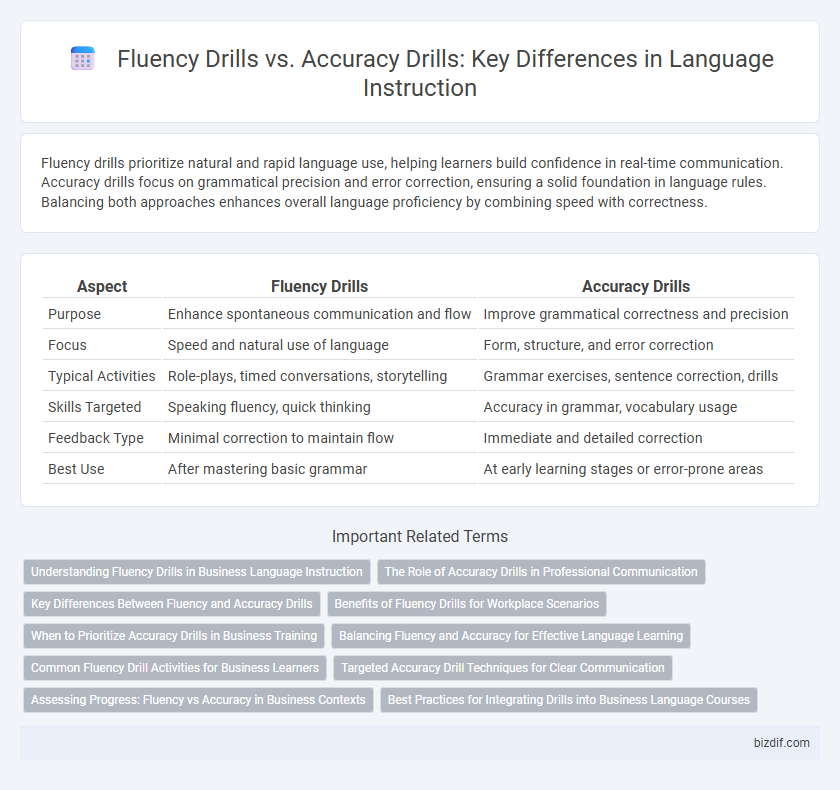Fluency drills prioritize natural and rapid language use, helping learners build confidence in real-time communication. Accuracy drills focus on grammatical precision and error correction, ensuring a solid foundation in language rules. Balancing both approaches enhances overall language proficiency by combining speed with correctness.
Table of Comparison
| Aspect | Fluency Drills | Accuracy Drills |
|---|---|---|
| Purpose | Enhance spontaneous communication and flow | Improve grammatical correctness and precision |
| Focus | Speed and natural use of language | Form, structure, and error correction |
| Typical Activities | Role-plays, timed conversations, storytelling | Grammar exercises, sentence correction, drills |
| Skills Targeted | Speaking fluency, quick thinking | Accuracy in grammar, vocabulary usage |
| Feedback Type | Minimal correction to maintain flow | Immediate and detailed correction |
| Best Use | After mastering basic grammar | At early learning stages or error-prone areas |
Understanding Fluency Drills in Business Language Instruction
Fluency drills in business language instruction prioritize smooth, spontaneous communication by encouraging learners to use business vocabulary and expressions in real-time scenarios like negotiations and presentations. These drills enhance conversational flow and help professionals develop confidence in using language naturally despite occasional errors. Emphasizing contextual relevance, fluency drills support learners in adapting language use to dynamic business environments, improving overall communication effectiveness.
The Role of Accuracy Drills in Professional Communication
Accuracy drills enhance professional communication by refining grammatical precision and vocabulary usage, crucial for clear and effective interactions. These drills minimize misunderstandings in high-stakes environments such as business meetings, negotiations, and presentations. Consistent practice with accuracy drills builds confidence and ensures messages are conveyed with exactness and professionalism.
Key Differences Between Fluency and Accuracy Drills
Fluency drills emphasize natural, spontaneous language use, prioritizing speed and communication effectiveness to build conversational confidence. Accuracy drills focus on grammatical correctness and precise language structure, aiming to minimize errors and reinforce proper language rules. The key difference lies in fluency drills fostering fluid speech, while accuracy drills ensure linguistic precision and error correction.
Benefits of Fluency Drills for Workplace Scenarios
Fluency drills enhance the ability to communicate smoothly and confidently in dynamic workplace situations, improving real-time problem-solving and collaboration. These exercises promote natural speech patterns and quick thinking, crucial for meetings, presentations, and negotiations. Consistent practice with fluency drills builds adaptability and reduces hesitation, leading to more effective and persuasive communication in professional environments.
When to Prioritize Accuracy Drills in Business Training
Accuracy drills should be prioritized in business training when precise communication is critical, such as in contract negotiations, legal discussions, or financial reporting. These drills improve grammatical correctness, vocabulary precision, and pronunciation clarity, reducing the risk of misunderstandings in high-stakes environments. Emphasizing accuracy ensures professionals convey messages clearly and maintain credibility in international or multilingual business settings.
Balancing Fluency and Accuracy for Effective Language Learning
Balancing fluency and accuracy drills is essential for effective language learning, as fluency drills enhance spontaneous communication while accuracy drills improve grammatical correctness. Implementing a structured routine that integrates both types ensures learners develop natural speech patterns without compromising linguistic precision. Research shows that combining interval training of fluency and accuracy leads to faster proficiency gains and better retention of language skills.
Common Fluency Drill Activities for Business Learners
Common fluency drill activities for business learners include role-playing meetings, simulated phone calls, and timed presentations that emphasize natural language flow and quick thinking. These activities enhance spontaneous communication skills crucial for negotiating, networking, and client interactions in professional settings. Incorporating real-world scenarios helps learners build confidence and improve conversational agility without sacrificing clarity.
Targeted Accuracy Drill Techniques for Clear Communication
Targeted accuracy drill techniques emphasize precise pronunciation, grammar, and vocabulary usage to enhance clear communication in language instruction. These drills focus on correcting specific language errors and reinforcing correct language patterns through repetitive, structured practice. Mastering accuracy drills leads to clearer articulation and minimizes misunderstandings, ultimately supporting effective and confident language use.
Assessing Progress: Fluency vs Accuracy in Business Contexts
Fluency drills in language instruction emphasize the ability to communicate ideas smoothly and quickly, crucial for dynamic business meetings and negotiations where timely responses impact outcomes. Accuracy drills prioritize precise grammar and vocabulary use, essential for drafting formal business documents and contracts requiring error-free communication. Assessing progress in fluency involves measuring conversational flow and response time, while accuracy assessment focuses on error frequency and language correctness in professional contexts.
Best Practices for Integrating Drills into Business Language Courses
Fluency drills in business language courses prioritize natural communication flow and speed, enhancing learners' ability to handle real-world interactions confidently. Accuracy drills focus on precision in grammar, vocabulary, and pronunciation to ensure professional and clear messaging in corporate settings. Balancing both drill types optimizes language proficiency by fostering spontaneous conversation skills alongside meticulous linguistic correctness, crucial for effective business communication.
Fluency Drills vs Accuracy Drills Infographic

 bizdif.com
bizdif.com